2018 Science Highlights
Disk Substructures at High Angular Resolution
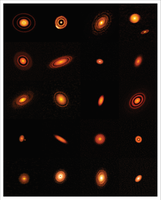 The Disk Substructures at High Angular Resolution Project (DSHARP) is one of the initial Large Programs conducted with ALMA. The primary goal of DSHARP is to find and characterize substructures in the spatial distributions of solid particles for a sample of 20 nearby protoplanetary disks, using very high resolution – approximately 0.035 arcseconds or 5 Astronomical Units (AU), Full Width at Half Maximum (FWHM) – observations of their 240 GHz (1.25 mm) continuum emission. These data provide a first homogeneous look at the small-scale features in disks that are directly relevant to the planet formation process, quantifying their prevalence, morphologies, spatial scales, spacings, symmetry, and amplitudes, for targets with a variety of disk and stellar host properties. The authors find that these substructures are ubiquitous in this sample of large, bright disks. They are most frequently manifested as concentric, narrow emission rings and depleted gaps, although large-scale spiral patterns and small arc-shaped azimuthal asymmetries are also present in some cases. These substructures are found at a wide range of disk radii (from a few AU to more than 100 AU), are usually compact (≤ 10 AU), and show a wide range of amplitudes (brightness contrasts). In this overview contribution, the authors discuss the motivation for the DSHARP project, describe the survey design and the sample properties, detail the observations and data calibration, highlight some basic results, and provide a general overview of the key conclusions that are presented in more detail in a series of accompanying articles, also published in Astrophysical Journal Letters. The DSHARP data – including visibilities, images, calibration scripts, and more – are released for community use at https://almascience.org/alma-data/lp/DSHARP.
The Disk Substructures at High Angular Resolution Project (DSHARP) is one of the initial Large Programs conducted with ALMA. The primary goal of DSHARP is to find and characterize substructures in the spatial distributions of solid particles for a sample of 20 nearby protoplanetary disks, using very high resolution – approximately 0.035 arcseconds or 5 Astronomical Units (AU), Full Width at Half Maximum (FWHM) – observations of their 240 GHz (1.25 mm) continuum emission. These data provide a first homogeneous look at the small-scale features in disks that are directly relevant to the planet formation process, quantifying their prevalence, morphologies, spatial scales, spacings, symmetry, and amplitudes, for targets with a variety of disk and stellar host properties. The authors find that these substructures are ubiquitous in this sample of large, bright disks. They are most frequently manifested as concentric, narrow emission rings and depleted gaps, although large-scale spiral patterns and small arc-shaped azimuthal asymmetries are also present in some cases. These substructures are found at a wide range of disk radii (from a few AU to more than 100 AU), are usually compact (≤ 10 AU), and show a wide range of amplitudes (brightness contrasts). In this overview contribution, the authors discuss the motivation for the DSHARP project, describe the survey design and the sample properties, detail the observations and data calibration, highlight some basic results, and provide a general overview of the key conclusions that are presented in more detail in a series of accompanying articles, also published in Astrophysical Journal Letters. The DSHARP data – including visibilities, images, calibration scripts, and more – are released for community use at https://almascience.org/alma-data/lp/DSHARP.
Image: ALMA's high-resolution images of nearby protoplanetary disks from the Disk Substructures at High Angular Resolution Project (DSHARP). Credit: ALMA (ESO/NAOJ/NRAO), S. Andrews et al.; NRAO/AUI/NSF, S. Dagnello.
Publication: Sean M. Andrews (Harvard–Smithsonian Center for Astrophysics) et al., The Disk Substructures at High Angular Resolution Project (DSHARP): I. Motivation, Sample, Calibration, and Overview, Astrophysical Journal Letters, 869, L41 (12 December 2018).
Kuiper Belt Objects & Their Moons
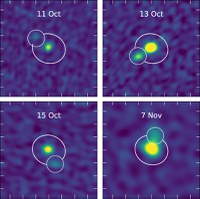 Most of the largest objects in the Kuiper Belt are known to have one or more satellites orbiting the parent body. The majority of these satellites have a small fractional brightness compared to their parent body. Even before the discovery of any of these small satellites, models predicted that giant impacts onto differentiated bodies would preferentially form icy satellites with a small fractional mass. Many of the known satellites to large Kuiper Belt Objects (KBOs) appear consistent with this paradigm. While satellites of mid- to small-KBOs tend to be similar in size and brightness to their primaries, the largest KBOs preferentially have satellites with small fractional brightness. In the two cases where the sizes and albedos of the small faint satellites have been measured, these satellites are seen to be small icy fragments consistent with collisional formation. In this research, the authors examine Dysnomia and Vanth, the satellites of Eris and Orcus, respectively. Using ALMA, the authors obtained the first spatially resolved observations of these systems at thermal wavelengths. Vanth is easily seen in individual images, and Dysnomia was detected at the 3.5σ level by stacking all the available data on the known position of the satellite. The diameter of Dysnomia and Vanth were calculated to be 700 ± 115 km and 475 ± 75 km, respectively, with albedos of 0.04 and 0.08, respectively. Both Dysnomia and Vanth are indistinguishable from typical Kuiper Belt objects of their size.
Most of the largest objects in the Kuiper Belt are known to have one or more satellites orbiting the parent body. The majority of these satellites have a small fractional brightness compared to their parent body. Even before the discovery of any of these small satellites, models predicted that giant impacts onto differentiated bodies would preferentially form icy satellites with a small fractional mass. Many of the known satellites to large Kuiper Belt Objects (KBOs) appear consistent with this paradigm. While satellites of mid- to small-KBOs tend to be similar in size and brightness to their primaries, the largest KBOs preferentially have satellites with small fractional brightness. In the two cases where the sizes and albedos of the small faint satellites have been measured, these satellites are seen to be small icy fragments consistent with collisional formation. In this research, the authors examine Dysnomia and Vanth, the satellites of Eris and Orcus, respectively. Using ALMA, the authors obtained the first spatially resolved observations of these systems at thermal wavelengths. Vanth is easily seen in individual images, and Dysnomia was detected at the 3.5σ level by stacking all the available data on the known position of the satellite. The diameter of Dysnomia and Vanth were calculated to be 700 ± 115 km and 475 ± 75 km, respectively, with albedos of 0.04 and 0.08, respectively. Both Dysnomia and Vanth are indistinguishable from typical Kuiper Belt objects of their size.
Image: ALMA observations of the Orcus–Vanth system. The images are centered on Orcus, and the predicted position of Vanth is circled. Tick marks in the images are 200 milli-arcseconds. Vanth is clearly detected even in the lower-resolution November 7 data.
Publication: Michael E. Brown (California Institute of Technology) & Bryan J. Butler (NRAO), Medium-sized Satellites of Large Kuiper Belt Objects, Astronomical Journal, 156, 164 (October 2018).
Capturing a Flare of Proxima Centauri
 Low mass M-type stars are the most common stars in the Galaxy and have a high frequency of Earth-sized planets. There is debate, however, as to what extent planets around M dwarfs would be amenable to life. Late M-type stars have long pre-main sequence phases during which the stellar luminosity can change significantly, as well as high stellar activity throughout their lifetimes. Proxima Centauri (spectral type M5.5V) has garnered tremendous recent interest due to the radial velocity detection of a potentially Earth-mass planet within the habitable zone and a new candidate transit event. At a distance of just 1.3 parsecs, Proxima Centauri b (mp sin I = 1.3 M⊕, a = 0.05 AU) is the closest extrasolar planet to the Solar System. Proxima Centauri has long been known as a flare star.
Low mass M-type stars are the most common stars in the Galaxy and have a high frequency of Earth-sized planets. There is debate, however, as to what extent planets around M dwarfs would be amenable to life. Late M-type stars have long pre-main sequence phases during which the stellar luminosity can change significantly, as well as high stellar activity throughout their lifetimes. Proxima Centauri (spectral type M5.5V) has garnered tremendous recent interest due to the radial velocity detection of a potentially Earth-mass planet within the habitable zone and a new candidate transit event. At a distance of just 1.3 parsecs, Proxima Centauri b (mp sin I = 1.3 M⊕, a = 0.05 AU) is the closest extrasolar planet to the Solar System. Proxima Centauri has long been known as a flare star.
MacGregor et al. present new analyses of ALMA 12m and Atacama Compact Array (ACA) observations at 233 GHz (1.3 mm) of the Proxima Centauri system acquired 21 January – 25 April 2017. These analyses reveal that the star underwent a significant flaring event during one of the ACA observations on 24 March 2017. The event lasted ~1 minute and reached a peak flux density nearly 1000X times brighter than the star’s quiescent emission. At the flare peak, the continuum emission is characterized by a steeply falling spectral index with frequency Fν ∝ να with α = −1.77 ± 0.45, and a lower limit on the fractional linear polarization of ∣Q / I∣ = 0.19 ± 0.02. Because the ACA observations do not show any quiescent excess emission, the authors conclude that there is no need to invoke the presence of a dust belt at 1–4 AU. They also posit that the slight excess flux density of 101 ± 9 μJy observed in the 12m observations, compared to the photospheric flux density of 74 ± 4 μJy extrapolated from infrared wavelengths, may be due to coronal heating from continual smaller flares, as is seen for AU Mic, another nearby well-studied M dwarf flare star.
Image: Millimeter emission from Proxima Centauri is detected only in a small subset of the ACA data. The left image combines all 13 ACA observations. The middle image shows the first 12 observations combined; the right image shows only the final observation. A point source is clearly detected at the stellar location only in the final observation. The blue star indicates the stellar position; the 7.27 x 5.51 arcsecond synthesized beam is indicated by the ellipse in the lower-left corner.
Publication: Meredith MacGregor (Carnegie) et al., Detection of a Millimeter Flare from Proxima Centauri, Astrophysical Journal Letters, 855, L2 (1 March 2018).
Radio Emission in Ultracool Dwarfs
Cool dwarf stars are the most common planetary hosts. They are also very active in radio flaring, and hence provide the best means to study star–planet magnetospheric interactions, and possibly their influence on the development of life.
To investigate the radio emission of ultracool objects, Guirado et al. carried out a targeted search in the recently discovered system VHS J125601.92–125723.9 (hereafter simply VHS 1256–1257). this system is composed of an equal-mass M7.5 binary and an L7 low-mass substellar object located at only 15.8 parsecs. The research team observed VHS 1256–1257 system with the Karl G. Jansky Very Large Array in phase-reference mode at X- and L-band, and with the European Very Long Baseline Interferometry Network at L-band, in several epochs during 2015 and 2016.
Radio emission was discovered at X-band that is spatially coincident with the equal-mass M7.5 binary with a flux density of 60 μJy. The measured spectral index was α = −1.1 ± 0.3 between 8 and 12 GHz, suggesting that non-thermal, optically thin, synchrotron, or gyrosynchrotron radiation is responsible for the observed radio emission. Interestingly, no signal is seen at L-band to a 3σ upper limit of 20 μJy. This might be explained by strong variability of the binary or self-absorption at this frequency. By adopting the latter scenario and gyrosynchrotron radiation, the authors constrain the turnover frequency to be in the interval 5–8.5 GHz, from which they infer the presence of kiloGauss-intense magnetic fields in the M7.5 binary. These data impose a 3σ upper bound to the radio flux density of the L7 object of 9 μJy at 10 GHz.
Image: [Left] VLA image of the VHS 1256–1257 field at X-band. The detected source is readily assigned to the M7.5 binary. The (undetected) L7-object b location is at the solid white box. The 3σ threshold detection is 9 μJy. At 15.8 parsecs, the separation between components AB and b corresponds to 128.4 AU. [Right] VLA image of the VHS 1256–1257 field at L-band. A solid box, with size that of the X-band image, is centered at the position of the X-band detection. None of the VHS 1256–1257 components is detected. The 3σ threshold detection is 20 μJy. The two bright knots seen in the map at the NW correspond to known extragalactic radio sources.
Publication: J.C. Guirado (Universitat de València) et al., Radio Emission in Ultracool Dwarfs: The Nearby Substellar Triple System, 2018, Astronomy & Astrophysics, 610, A23.
Spotting a Rogue, Giant Magnetized Planet
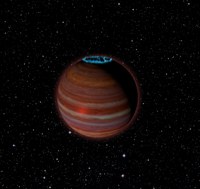 Characterizing magnetic fields in the coolest dwarfs and eventually exoplanets can provide valuable insight into the formation, emission, and evolution of planets through stars. Kao et al. used the Karl G. Jansky Very Large Array to observe a sample of five known radio-emitting late-L and T dwarfs ranging in age from ∼0.2 to 3.4 Gigayears (Gyr). Each target was observed for seven hours, extending to higher frequencies than previously attempted and establishing proportionally higher limits on maximum surface magnetic field strengths. Detections of circularly polarized pulses at 8–12 GHz yield measurements of 3.2–4.1kG localized magnetic fields on four targets, including the archetypal cloud variable and likely planetary-mass object T2.5 dwarf SIMP J01365663+0933473. A pulse at 15–16.5 GHz was also detected for the T6.5 dwarf 2MASS 10475385 +2124234, corresponding to a localized 5.6 kG field strength. For the same object, a 16.5–18 GHz pulse was tentatively detected, corresponding to a localized 6.2 kG field strength. Rotation periods were measured between ∼1.47 – 2.28 hours for 2MASS J10430758+2225236, 2MASS J12373919+6526148, and SDSS J04234858–0414035, supporting: (a) an emerging consensus that rapid rotation may be important for producing strong dipole fields in convective dynamos; and/or (b) rapid rotation is a key ingredient for driving the current systems powering auroral radio emission. The authors observe evidence of variable structure in the frequency-dependent time series of our targets on timescales shorter than a rotation period, suggesting a higher degree of variability in the current systems near the surfaces of brown dwarfs. Age, mass, and temperature together cannot account for the strong magnetic fields produced by our targets.
Characterizing magnetic fields in the coolest dwarfs and eventually exoplanets can provide valuable insight into the formation, emission, and evolution of planets through stars. Kao et al. used the Karl G. Jansky Very Large Array to observe a sample of five known radio-emitting late-L and T dwarfs ranging in age from ∼0.2 to 3.4 Gigayears (Gyr). Each target was observed for seven hours, extending to higher frequencies than previously attempted and establishing proportionally higher limits on maximum surface magnetic field strengths. Detections of circularly polarized pulses at 8–12 GHz yield measurements of 3.2–4.1kG localized magnetic fields on four targets, including the archetypal cloud variable and likely planetary-mass object T2.5 dwarf SIMP J01365663+0933473. A pulse at 15–16.5 GHz was also detected for the T6.5 dwarf 2MASS 10475385 +2124234, corresponding to a localized 5.6 kG field strength. For the same object, a 16.5–18 GHz pulse was tentatively detected, corresponding to a localized 6.2 kG field strength. Rotation periods were measured between ∼1.47 – 2.28 hours for 2MASS J10430758+2225236, 2MASS J12373919+6526148, and SDSS J04234858–0414035, supporting: (a) an emerging consensus that rapid rotation may be important for producing strong dipole fields in convective dynamos; and/or (b) rapid rotation is a key ingredient for driving the current systems powering auroral radio emission. The authors observe evidence of variable structure in the frequency-dependent time series of our targets on timescales shorter than a rotation period, suggesting a higher degree of variability in the current systems near the surfaces of brown dwarfs. Age, mass, and temperature together cannot account for the strong magnetic fields produced by our targets.
Image: Artist's conception of SIMP J01365663+0933473, an object with 12.7 times the mass of Jupiter, but a magnetic field 200 times more powerful than Jupiter's. This object is 20 light-years from Earth. Credit: Chuck Carter, Caltech, NRAO/AUI/NSF
Publication: Melodie M. Kao (California Institute of Technology, Arizona State University) et al., The Strongest Magnetic Fields on the Coolest Brown Dwarfs, Astrophysical Journal Supplement Series, 237, 25 (August 2018).
Superluminal Motion of a Relativistic Jet in a Neutron Star merger
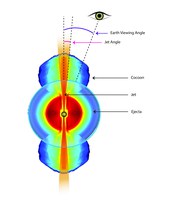 The binary neutron-star merger GW170817 was accompanied by radiation across the electromagnetic spectrum and localized to the galaxy NGC 4993 (d ~ 41 Mpc). The radio and X-ray afterglows of GW170817 exhibited delayed onset, a gradual increase in the emission with time (proportional to t 0.8) to a peak ~150 days after the merger event, followed by a relatively rapid decline. Models have been proposed to explain the afterglow emission, including a choked-jet cocoon and a successful-jet cocoon / structured jet. However, the observational data have remained inconclusive regarding whether GW170817 launched a successful relativistic jet. Mooley et al. report radio observations acquired via Very Long Baseline Interferometry conducted with the Very Long Baseline Array, the Karl G. Jansky Very Large Array, and the Green Bank Telescope. The authors find that the compact radio source associated with GW170817 exhibits superluminal apparent motion between 75 days and 230 days after the merger event. This measurement breaks the degeneracy between the choked- and successful-jet cocoon models and indicates that, although the early-time radio emission was powered by a wide-angle outflow (a cocoon), the late-time emission was likely dominated by an energetic and narrowly collimated jet with an opening angle of less than five degrees, observed from a viewing angle of ~ 20 degrees. The imaging of a collimated relativistic outflow emerging from GW170817 adds substantial weight to the evidence linking binary neutron-star mergers and short γ-ray bursts.
The binary neutron-star merger GW170817 was accompanied by radiation across the electromagnetic spectrum and localized to the galaxy NGC 4993 (d ~ 41 Mpc). The radio and X-ray afterglows of GW170817 exhibited delayed onset, a gradual increase in the emission with time (proportional to t 0.8) to a peak ~150 days after the merger event, followed by a relatively rapid decline. Models have been proposed to explain the afterglow emission, including a choked-jet cocoon and a successful-jet cocoon / structured jet. However, the observational data have remained inconclusive regarding whether GW170817 launched a successful relativistic jet. Mooley et al. report radio observations acquired via Very Long Baseline Interferometry conducted with the Very Long Baseline Array, the Karl G. Jansky Very Large Array, and the Green Bank Telescope. The authors find that the compact radio source associated with GW170817 exhibits superluminal apparent motion between 75 days and 230 days after the merger event. This measurement breaks the degeneracy between the choked- and successful-jet cocoon models and indicates that, although the early-time radio emission was powered by a wide-angle outflow (a cocoon), the late-time emission was likely dominated by an energetic and narrowly collimated jet with an opening angle of less than five degrees, observed from a viewing angle of ~ 20 degrees. The imaging of a collimated relativistic outflow emerging from GW170817 adds substantial weight to the evidence linking binary neutron-star mergers and short γ-ray bursts.
Image: Aftermath of the merger of two neutron stars. Ejecta from an initial explosion formed a shell around the black hole formed from the merger. A jet of material propelled from a disk surrounding the black hole first interacted with the ejecta material to form a broad cocoon. Later, the jet broke through to emerge into interstellar space, where its extremely fast motion became apparent. Credit: Sophia Dagnello, NRAO/AUI/NSF
Publication: K. P. Mooley (NRAO, Caltech) et al., Superluminal motion of a relativistic jet in the neutron-star merger GW170817, Nature, 561, 355-359 (2018).
An Orphan Gamma-ray Burst
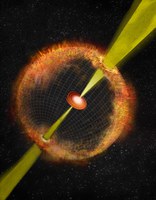 Casey Law et al. present the discovery of a slowly evolving, extragalactic radio transient, FIRST J141918.9+394036, identified by comparing a catalog of radio sources in nearby galaxies against new observations from the Very Large Array Sky Survey. Analysis of other archival data shows that FIRST J141918.9+394036 faded by a factor of ~50 over 23 years, from a flux of ~26 mJy at 1.4 GHz in 1993 to an upper limit of 0.4 mJy at 3 GHz in 2017. FIRST J141918.9+394036 is likely associated with the small star-forming galaxy SDSS J141918.81+394035.8 at a redshift z = 0.01957 (d = 87 Mpc), which implies a peak luminosity νL ν ≳ 3 × 1038 erg/sec. If interpreted as an isotropic synchrotron blast wave, the source requires an explosion of kinetic energy ~1051 erg some time prior to the authors’ first detection in late 1993. This explosion is most likely associated with a long gamma-ray burst (GRB), but the radio source could also be interpreted as the nebula of a newly-born magnetar. The radio discovery of either of these phenomena would be unprecedented. Joint consideration of the event light curve, host galaxy, lack of a counterpart GRB, and volumetric rate suggests that FIRST J141918.9+394036 is the afterglow of an off-axis ("orphan") long GRB. The long time baseline of this event offers the best available constraint in afterglow evolution as the bulk of shock-accelerated electrons become non-relativistic. The proximity, age, and precise localization of FIRST J141918.9+394036 make it a key object for understanding the aftermath of rare classes of stellar explosion.
Casey Law et al. present the discovery of a slowly evolving, extragalactic radio transient, FIRST J141918.9+394036, identified by comparing a catalog of radio sources in nearby galaxies against new observations from the Very Large Array Sky Survey. Analysis of other archival data shows that FIRST J141918.9+394036 faded by a factor of ~50 over 23 years, from a flux of ~26 mJy at 1.4 GHz in 1993 to an upper limit of 0.4 mJy at 3 GHz in 2017. FIRST J141918.9+394036 is likely associated with the small star-forming galaxy SDSS J141918.81+394035.8 at a redshift z = 0.01957 (d = 87 Mpc), which implies a peak luminosity νL ν ≳ 3 × 1038 erg/sec. If interpreted as an isotropic synchrotron blast wave, the source requires an explosion of kinetic energy ~1051 erg some time prior to the authors’ first detection in late 1993. This explosion is most likely associated with a long gamma-ray burst (GRB), but the radio source could also be interpreted as the nebula of a newly-born magnetar. The radio discovery of either of these phenomena would be unprecedented. Joint consideration of the event light curve, host galaxy, lack of a counterpart GRB, and volumetric rate suggests that FIRST J141918.9+394036 is the afterglow of an off-axis ("orphan") long GRB. The long time baseline of this event offers the best available constraint in afterglow evolution as the bulk of shock-accelerated electrons become non-relativistic. The proximity, age, and precise localization of FIRST J141918.9+394036 make it a key object for understanding the aftermath of rare classes of stellar explosion.
Image: Radio images of FIRST J1419+3940 from 1993 to 2017 show its slow fade. Credit: Law et al., Bill Saxton, NRAO/AUI/NSF
Publication: C.J. Law (University of California, Berkeley) et al., Discovery of the Luminous, Decades-long, Extragalactic Radio Transient FIRST J141918.9+394036, Astrophysical Journal Letters, 866, L22 (20 October 2018).
Identifying the Source of a High-energy Neutrino
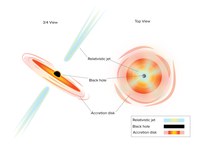 Previous detections of individual astrophysical sources of neutrinos are limited to the Sun and Supernova 1987A, whereas the origins of the diffuse flux of high-energy cosmic neutrinos remain unidentified. On 22 September 2017, the IceCube Neutrino Observatory sensors, distributed throughout a square kilometer of ice under the South Pole, detected a high-energy neutrino, IceCube-170922A. Its arrival direction was consistent with the location of a γ-ray blazar, TXS 0506+056, observed to be in a flaring state. An extensive multiwavelength campaign followed, ranging from radio frequencies to γ-rays. These observations characterized the variability and energetics of the blazar. This observation of a neutrino in spatial coincidence with a γ-ray–emitting blazar during an active phase suggests that blazars may be a source of high-energy neutrinos. Following the IceCube detection, astronomers looked at TXS 0506+056 with numerous telescopes and found that it had brightened in gamma rays, X-rays, and visible light. Tracking the high-energy neutrino detected by IceCube to TXS 0506+056 marks the first time a specific object has been identified as the probable source of such a high-energy neutrino.
Previous detections of individual astrophysical sources of neutrinos are limited to the Sun and Supernova 1987A, whereas the origins of the diffuse flux of high-energy cosmic neutrinos remain unidentified. On 22 September 2017, the IceCube Neutrino Observatory sensors, distributed throughout a square kilometer of ice under the South Pole, detected a high-energy neutrino, IceCube-170922A. Its arrival direction was consistent with the location of a γ-ray blazar, TXS 0506+056, observed to be in a flaring state. An extensive multiwavelength campaign followed, ranging from radio frequencies to γ-rays. These observations characterized the variability and energetics of the blazar. This observation of a neutrino in spatial coincidence with a γ-ray–emitting blazar during an active phase suggests that blazars may be a source of high-energy neutrinos. Following the IceCube detection, astronomers looked at TXS 0506+056 with numerous telescopes and found that it had brightened in gamma rays, X-rays, and visible light. Tracking the high-energy neutrino detected by IceCube to TXS 0506+056 marks the first time a specific object has been identified as the probable source of such a high-energy neutrino.
The Very Large Array (VLA) observed TXS 0506+056 in several radio bands from 2 to 12 GHz, beginning two weeks after the alert, detecting significant radio flux variability and some spectral variability of this source. The source is also in the long-term blazar monitoring program of the Owens Valley Radio Observatory 40m telescope at 15 GHz. The light curve shows a gradual increase in radio emission during the 18 months preceding the neutrino alert. TXS 0506+056 has also been monitored for years with the Very Long Baseline Array (VLBA). VLBA images have shown bright knots of radio emission that travel outward within the jets at nearly the speed of light. The knots presumably are caused by denser material ejected sporadically through the jet.
Image: A supermassive black hole at the core of a galaxy accelerates particles in jets moving outward at nearly the speed of light. In a blazar, one of these jets is pointed nearly straight at Earth. Credit: Sophia Dagnello, NRAO/AUI/NSF
Publication: The IceCube Collaboration et al., Multimessenger observations of a flaring blazar coincident with high-energy neutrino IceCube-170922A, Science, 361, 146 (No. 6398, 11 July 2018).
The Physics of Jet Formation
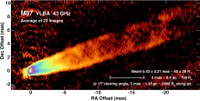 The central radio source in Messier 87 (M87) provides the best opportunity to study jet formation owing to its large angular size for the gravitational radius of the black hole and its bright jet that is well resolved by very long baseline interferometry observations. Walker et al. present intensive monitoring observations from 2007 and 2008, plus approximately annual observations that span 17 years, all conducted with the Very Long Baseline Array (VLBA) at 43 GHz with a resolution of ~30 RS x 60 RS. The high dynamic range of these images clearly show the wide opening angle structure and the counterjet. The jet and counterjet are nearly symmetric in the inner 1.5 milli-arcseconds (0.12 parsec in projection), with both being edge brightened. Both show deviations from parabolic shape in the form of an initial rapid expansion and subsequent contraction followed by further rapid expansion and, beyond the visible counterjet, subsequent collimation. Proper motions and counterjet / jet intensity ratios both indicate acceleration from apparent speeds of ≲ 0.5c to ≳ 2c in the inner ~2 milli-arcseconds and suggest a helical flow. The jet displays a sideways shift with an ~8–10 year quasi-periodicity. The shift propagates outward nonballistically and significantly more slowly than the flow speed revealed by the fastest-moving components. Polarization data show a systematic structure with magnetic field vectors that suggest a toroidal field close to the core.
The central radio source in Messier 87 (M87) provides the best opportunity to study jet formation owing to its large angular size for the gravitational radius of the black hole and its bright jet that is well resolved by very long baseline interferometry observations. Walker et al. present intensive monitoring observations from 2007 and 2008, plus approximately annual observations that span 17 years, all conducted with the Very Long Baseline Array (VLBA) at 43 GHz with a resolution of ~30 RS x 60 RS. The high dynamic range of these images clearly show the wide opening angle structure and the counterjet. The jet and counterjet are nearly symmetric in the inner 1.5 milli-arcseconds (0.12 parsec in projection), with both being edge brightened. Both show deviations from parabolic shape in the form of an initial rapid expansion and subsequent contraction followed by further rapid expansion and, beyond the visible counterjet, subsequent collimation. Proper motions and counterjet / jet intensity ratios both indicate acceleration from apparent speeds of ≲ 0.5c to ≳ 2c in the inner ~2 milli-arcseconds and suggest a helical flow. The jet displays a sideways shift with an ~8–10 year quasi-periodicity. The shift propagates outward nonballistically and significantly more slowly than the flow speed revealed by the fastest-moving components. Polarization data show a systematic structure with magnetic field vectors that suggest a toroidal field close to the core.
Image: The 23-epoch average radio image of the jet and counterjet in M87 based on data from 2007 and 2008. Angular to linear scales (in parsecs and Schwarzschild radii, RS) are indicated for distances in the sky plane and for distances along the axis of the jet assuming that it is oriented at 17° to the line-of-sight. The beam with resolution 0.43 × 0.21 milli-arcsecond elongated in position angle −16° is at lower left. The off-source noise level is 62 μJy/beam; the image peak is 0.83 Jy.
Publication: R. Craig Walker (NRAO) et al., The Structure and Dynamics of the Subparsec Jet in M87 Based on 50 VLBA Observations over 17 Years at 43 GHz, Astrophysical Journal, 855, 128 (10 March 2018).
The Dense Gas History of the Universe
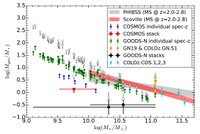 The authors describe the CO Luminosity Density at High-z (COLDz) survey, the first spectral line deep field targeting CO(1–0) emission from galaxies at z = 1.95 – 2.85 and CO(2–1) at z = 4.91–6.70. The main goal of COLDz is to constrain the cosmic density of molecular gas at the peak epoch of cosmic star formation. By targeting both a wide (~51 arcmin2) and a deep (~9 arcmin2) area, the survey is designed to robustly constrain the bright end and the characteristic luminosity of the CO(1–0) luminosity function. An extensive analysis of the reliability of the survey’s line candidates and new techniques provides detailed completeness and statistical corrections as necessary to determine the best constraints to date on the CO luminosity function. The blind search for CO(1–0) uniformly selects starbursts and massive main-sequence galaxies based on their cold molecular gas masses. The search also detects CO(2–1) line emission from optically dark, dusty star-forming galaxies at z > 5. Pavesi et al. find a range of spatial sizes for the CO-traced gas reservoirs up to ~40 kiloparsecs, suggesting that spatially extended cold molecular gas reservoirs may be common in massive, gas-rich galaxies at z ~ 2. Through CO line stacking, they constrain the gas mass fraction in previously known typical star-forming galaxies at z = 2 – 3. The stacked CO detection suggests lower molecular gas mass fractions than expected for massive main-sequence galaxies by a factor of ~3–6. The authors find total CO line brightness at ~34 GHz of 0.45 ± 0.2 μK, which constrains future line intensity mapping and Cosmic Microwave Background experiments.
The authors describe the CO Luminosity Density at High-z (COLDz) survey, the first spectral line deep field targeting CO(1–0) emission from galaxies at z = 1.95 – 2.85 and CO(2–1) at z = 4.91–6.70. The main goal of COLDz is to constrain the cosmic density of molecular gas at the peak epoch of cosmic star formation. By targeting both a wide (~51 arcmin2) and a deep (~9 arcmin2) area, the survey is designed to robustly constrain the bright end and the characteristic luminosity of the CO(1–0) luminosity function. An extensive analysis of the reliability of the survey’s line candidates and new techniques provides detailed completeness and statistical corrections as necessary to determine the best constraints to date on the CO luminosity function. The blind search for CO(1–0) uniformly selects starbursts and massive main-sequence galaxies based on their cold molecular gas masses. The search also detects CO(2–1) line emission from optically dark, dusty star-forming galaxies at z > 5. Pavesi et al. find a range of spatial sizes for the CO-traced gas reservoirs up to ~40 kiloparsecs, suggesting that spatially extended cold molecular gas reservoirs may be common in massive, gas-rich galaxies at z ~ 2. Through CO line stacking, they constrain the gas mass fraction in previously known typical star-forming galaxies at z = 2 – 3. The stacked CO detection suggests lower molecular gas mass fractions than expected for massive main-sequence galaxies by a factor of ~3–6. The authors find total CO line brightness at ~34 GHz of 0.45 ± 0.2 μK, which constrains future line intensity mapping and Cosmic Microwave Background experiments.
Image: The molecular gas mass fraction constraints for galaxies with spectroscopic redshifts for which the CO(1–0) emission can be constrained by the COLDz data. The color points assume αCO = 3.6M⊙ (K km s−1 pc2)−1; the gray points correspond to adopting the metallicity-dependent αCO from Genzel et al. (2015). Upper limits are 3σ and assume a line FWHM of 300 km/sec. The gray and red shaded regions correspond to the reported average expected gas mass fraction in the range z ∼ 2.0–2.8 for main-sequence galaxies.
Publication: Riccardo Pavesi (Cornell University) et al., The CO Luminosity Density at High-z (COLDz) Survey: A Sensitive, Large-area Blind Search for Low-J CO Emission from Cold Gas in the Early Universe with the Karl G. Jansky Very Large Array, Astrophysical Journal, 864, 49 (1 September 2018).
A Massive Galaxy in the Early Universe
According to our current understanding of cosmic structure formation, the precursors of the most massive structures in the Universe began to form shortly after the Big Bang, in regions corresponding to the largest fluctuations in the cosmic density field. Observing these structures during their period of active growth and assembly—the first few hundred million years of the Universe—is challenging because it requires surveys that are sensitive enough to detect the distant galaxies that act as signposts for these structures and wide enough to capture the rarest objects. As a result, very few such objects have been detected to date.
In this contribution, Marrone et al. report observations of a far-infrared-luminous object at redshift 6.900– just 780 million years after the Big Bang–that was discovered in a wide-field survey. This object, SPT0311−58, was originally identified in the 2,500-deg2 South Pole Telescope survey as a luminous source with a steeply increasing spectrum, indicative of thermal dust emission. Observations with ALMA provide the redshift of the source.
High-resolution imaging shows it to be a pair of extremely massive star-forming galaxies. The larger is forming stars at a rate of 2,900 M⊙ per year, contains 270 billion M⊙ of gas and 2.5 billion M⊙ of dust, and is more massive than any other known object at a redshift of more than 6. Its rapid star formation is probably triggered by its companion galaxy at a projected separation of 8 kiloparsecs. This merging companion hosts 35 billion M⊙ of stars and has a star-formation rate of 540 M⊙ per year, but has an order of magnitude less gas and dust than its neighbor and physical conditions akin to those observed in lower-metallicity galaxies in the nearby Universe. These objects suggest the presence of a dark-matter halo with a mass of more than 100 billion M⊙, making it among the rarest dark-matter haloes that should exist in the Universe at this epoch.
Image: Image & spectra of the [CII] and [OIII] emission from the z=6.9 lensed starburst galaxy SPT0311-58.
Publication: D.P. Marrone (Steward Observatory, University of Arizona) et al., Galaxy Growth in a Massive Halo in the First Billion Years of Cosmic History, 4 January 2018, Nature, 553, 51.
The Onset of Star Formation in the Universe
A fundamental quest of modern astronomy is to locate the earliest galaxies and study how they influenced the intergalactic medium a few hundred million years after the Big Bang. The abundance of star-forming galaxies is known to decline from redshifts of about 6 to 10, but a key question is the extent of star formation at even earlier times, corresponding to the period when the first galaxies might have emerged. In this paper, Hashimoto et al. report spectroscopic observations of MACS1149-JD1, a gravitationally-lensed galaxy observed when the Universe was less than 4% of its present age. Between March 2016 and April 2017, the team performed observations of MACS1149-JD1 at the Atacama Large Millimeter/submillimeter Array (ALMA), targeting the far-infrared oxygen line, [O III] at a wavelength of 88 μm, and dust continuum emission over a broad wavelength range consistent with its photometric redshift range (z ~ 9.0–9.8). An emission line of doubly ionized oxygen was detected at a redshift of 9.1096 ± 0.0006, with an uncertainty of one standard deviation. This precisely determined redshift indicates that the red rest-frame optical color arises from a dominant stellar component that formed about 250 million years after the Big Bang, corresponding to a redshift of ~15. These results indicate that it may be possible to detect such early episodes of star formation in similar galaxies with future telescopes.
Image: The galaxy cluster MACS J1149.5+2223 as seen with the Hubble Space Telescope. The inset image is the galaxy MACS1149-JD1 observed with ALMA. The oxygen detected with ALMA is in green. Credit: ALMA (ESO/NAOJ/NRAO), NASA/ESA Hubble Space Telescope, W. Zheng (JHU), M. Postman (STScI), the CLASH Team, Hashimoto et al.
Publication: T. Hashimoto (Osaka Sangyo University, National Astronomical Observatory of Japan) et al., The onset of star formation 250 million years after the Big Bang, Nature (17 May 2018).
Solving the Mystery of Gravitational-wave EM Sources
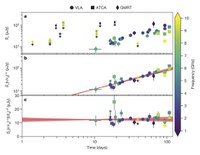 GW170817 was the first gravitational-wave detection of a binary neutron-star merger. This event was accompanied by radiation across the electromagnetic spectrum and localized to the galaxy NGC 4993 at a distance of 40 Megaparsecs. It has been proposed that the observed γ-ray, X-ray and radio emission is due to an ultra-relativistic jet being launched during the merger successfully breaking out of the surrounding material, directed away from our line-of-sight. The presence of such a jet is predicted from models that posit neutron-star mergers as the drivers of short hard γ-ray bursts. In this contribution, Mooley et al. report that the radio light curve of GW170817 has no direct signature of the afterglow of an off-axis jet. Although the existence of a jet directed away from the line of sight cannot be completely ruled out, the observed γ-ray emission could not have originated from such a jet. Instead, the radio data require the existence of a mildly relativistic wide-angle outflow moving towards Earth. This outflow could be the high-velocity tail of the neutron-rich material that was ejected dynamically during the merger, or a cocoon of material that breaks out when a jet launched during the merger transfers its energy to the dynamical ejecta. Because the cocoon model explains the radio light curve of GW170817, as well as the γ-ray and X-ray emission, and possibly also the ultraviolet and optical emission, it is the model that is most consistent with the observational data. Cocoons may be a ubiquitous phenomenon produced in neutron-star mergers, giving rise to a hitherto unidentified population of radio, ultraviolet, X-ray and γ-ray transients in the local Universe.
GW170817 was the first gravitational-wave detection of a binary neutron-star merger. This event was accompanied by radiation across the electromagnetic spectrum and localized to the galaxy NGC 4993 at a distance of 40 Megaparsecs. It has been proposed that the observed γ-ray, X-ray and radio emission is due to an ultra-relativistic jet being launched during the merger successfully breaking out of the surrounding material, directed away from our line-of-sight. The presence of such a jet is predicted from models that posit neutron-star mergers as the drivers of short hard γ-ray bursts. In this contribution, Mooley et al. report that the radio light curve of GW170817 has no direct signature of the afterglow of an off-axis jet. Although the existence of a jet directed away from the line of sight cannot be completely ruled out, the observed γ-ray emission could not have originated from such a jet. Instead, the radio data require the existence of a mildly relativistic wide-angle outflow moving towards Earth. This outflow could be the high-velocity tail of the neutron-rich material that was ejected dynamically during the merger, or a cocoon of material that breaks out when a jet launched during the merger transfers its energy to the dynamical ejecta. Because the cocoon model explains the radio light curve of GW170817, as well as the γ-ray and X-ray emission, and possibly also the ultraviolet and optical emission, it is the model that is most consistent with the observational data. Cocoons may be a ubiquitous phenomenon produced in neutron-star mergers, giving rise to a hitherto unidentified population of radio, ultraviolet, X-ray and γ-ray transients in the local Universe.
Image: [a] The flux densities Sν correspond to the detections (markers with 1σ error bars) and upper limits (downward-pointing arrows) of GW170817 from 0.6 – 15 GHz (black for ≤1 GHz; yellow for ≥10 GHz) between days 16 and 107 after the merger. The marker shapes denote measurements from different telescopes. [b] Same as a, but with flux densities corrected for the spectral index α = −0.61and with early-time, non-constraining upper limits removed. The light curve fit with temporal index δ = 0.78 is the red line and the uncertainty in δ (±0.05) as the red shaded region. [c] Residual plot after correcting for the spectral and temporal variations.
Publication: K.P. Mooley (Oxford, NRAO, California Institute of Technology) et al., A Mildly Relativistic Wide-angle Outflow in the Neutron-star Merger Event GW170817, 8 February 2018, Nature, 554, 207.


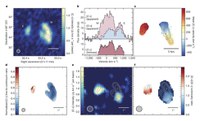
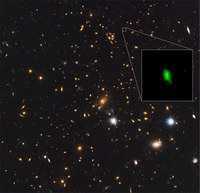



Connect with NRAO